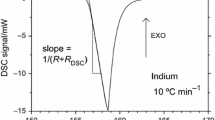Abstract
The DSC curve of freeze-dried amorphous sucrose shows the glass transition, the crystallization and the melting (just before decomposition) of the sample. Sucrose crystallization occurs below 100°C: this phenomenon can therefore be observed with the microcalorimeter Setaram Micro-DSC used in the scanning mode. Mixtures of amorphous and crystalline sucrose in known proportions were used to calibrate the instrument. Low level amorphism (down to about 0.5%) could be detected and quantitatively evaluated on the basis of the crystallization enthalpies determined. The calibration curve obtained can be applied to determine the degree of amorphism in milled sucrose. A simple gravimetric method, based on the desorption of water induced by recrystallization of the amorphous layer can be used to obtain similar data more rapidly. This simple method is particularly useful for controlling the amorphism on line during a process, and is also briefly described.
Zusammenfassung
Die DSC-Kurve von gefriergetrockneter amorpher Saccharose zeigt den Glasumwandlungspunkt, die Kristallisation und (kurz vor der Zersetzung) das Schmelzen der Probe. Die Kristallisation von Saccharose erfolgt, unterhalb 100°C: diese Erscheinung kann deshalb mit einem Setaram Micro-DSC Mikrokalorimeter in der Betriebsart Scanning erfaßt werden. Zur Kalibrierung des Gerätes wurden Gemische aus amorpher und kristalliner Saccharose bekannter Zusammensetzung verwendet. Auf der Grundlage der bestimmten Kristallisationsenthalpien konnte eine low-level-Amorphie (herab bis etwa 0,5%) erfaßt und quantitativ ermittelt werden. Die Kalibrationskurve kann zur Bestimmung des Amorphiegrades von gemahlener Saccharose verwendet werden. Auf der Basis von durch Rekristallisation der amorphen Schicht induzierter Wasserdesorption kann eine einfache gravimetrische Methode eingesetzt werden, um ähnliche Angaben noch schneller zu erhalten. Diese einfache Methode ist besonders nützlich für eine on-line-Kontrolle der Amorphie während eines Verfahrensprozesses und wird ebenfalls kurz beschrieben.
Similar content being viewed by others
References
Y. H. Roos, Phase transitions and transformations in food systems, Handbook of Food Engineering, D. R. Heldman and D. B. Lund (eds), Marcel Dekker Inc., New York 1992.
Y. H. Roos and M. Karel, J. Food Sci., 56 (1991) 38.
A. Raemy and T. F. Schweizer, J. Thermal Anal., 28 (1983) 95.
E. C. To and J. M. Flink, J. Food Technol., 13 (1978) 583.
T. M. Herrington and A. C. Branfield, J. Food Technol., 19 (1984) 409.
B. Makower and W. B. Dye, Agric. and Food Chem., 4 (1956) 72.
H. A. Iglesias and J. Chirife, J. Food Technol., 13 (1978) 137.
J. T. Carstensen and K. V. Scoik, Pharmaceutical Research, 7 (1990) 1278.
E. A. Niediek, The Manufacturing Confectioner, 6 (1991) 91.
J. Chevalley, W. Rostagno and R. H. Egli, Rev. Int. Chocolat, 9 (1969) 377.
Author information
Authors and Affiliations
Rights and permissions
About this article
Cite this article
Raemy, A., Kaabi, C., Ernst, E. et al. Precise determination of low level sucrose amorphism by microcalorimetry. Journal of Thermal Analysis 40, 437–444 (1993). https://doi.org/10.1007/BF02546612
Published:
Issue Date:
DOI: https://doi.org/10.1007/BF02546612




